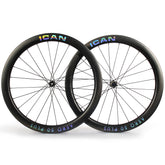Discover the truth: Chinese carbon frames are of exceptional quality
Are the Chinese carbon frames good?
Some Western cyclists are hesitant to purchase a Chinese-made carbon frame. Your main objection seems to be based on price - on the assumption that the most expensive product must also be the best. This attitude has led to luxury liquor and cosmetics brands flourishing in the West.
These days some cyclists brag about how much their machines cost. A hand-built English professional steel competition frame cost $22 in 1958; today the inflated prices are $2,670. It is even a falsehood that Chinese carbon frames cost less because they are made by robots - like Tesla cars. And the Chinese industry is also accused of being a newcomer - a Johnny has recently entered the global market.
Now let's clear up some misconceptions about Chinese carbon frames. First, the idea that the industry is new and opportunistic.
China has been a major cycling nation since 1950, when Huo Baji took the English Raleigh Roadster from 1933 as a model and launched the legendary Flying Pigeon brand. Over the next 70 years, China became known as the Kingdom of Bicycles. The price of a single-aisle Flying Pigeon was 150 yuan, equivalent to four months of a worker's salary, and there was a waiting list that lasted years.
In 2005, Western pop star Katie Melua had a big hit, a love song with this title: There are nine million bicycles in Beijing. No one has disputed this figure, as the factory claims to have produced 500 million bicycles since 1950. Today the Flying Pigeons are in operation all over China. They are still on display at the annual Shanghai Bicycle Show, which features 6,000 booths and is attended by industry representatives from around the world.
When it comes to design, the Chinese industry relies on local and international research and talent. State-of-the-art frame geometries may have been conceived by a genius at the drawing board in Shenzhen, Toronto, Milan, Birmingham or New Jersey. "Imitation" frames are few and far between, and basic research is still ongoing. The truth about the untruth of robot assembly is this: a Chinese carbon frame goes into a lot of skilled handwork before and after the oven.
This starts with a laminate made of Toray 700 and 800 fibers. It takes a worker two hours to complete the build, applying polymer resin to the fibers on a jig and attaching up to 500 strips one at a time in a specific order. There are no shortcuts and each strip is designed to maximize the performance of the frame. Each strip must be installed in a precise order to meet the design parameters. Reinforcement strips that underlay parts that are being drilled or elements such as struts and bottom brackets must be as stiff as possible. Complicated structures such as the head tube are laid separately and added later. Inside the tubes there is a disposable mandrel that maintains the internal shape. This can be inflatable and will be destroyed by the heat of the oven or removed later.
The manufactured frame comes in a mold that costs up to $200,000. And each size of a particular model requires its own form. So making carbon frames is not for casual workers or unconventional companies. After the frame is covered with a plastic film that is vacuumed, it and the mold go into the oven for 60 minutes. When the carbon frame has cooled and is removed from the mold, it looks like a diamond in the rough, although it is very light and stiff. It takes a skilled worker an average of 90 minutes to sand and polish the frame to make it smooth.
The next step is to coat the frame with spray paint in a clean room. Once the paint has dried, decals are applied using the water transfer process before a final clear coat is sprayed on. Then follows a relentless quality control. Some manufacturers perform a vibration test, others even go as far as x-raying the frames.
To compare two examples of premium carbon pro frames, the ICAN A9 is a state-of-the-art Chinese road frame that comes with a carbon seatpost, stem and handlebars for $930. You might think that an example of the US-made Specialized S-works Aethos frame was dusted with a little magic dust. In lightly used condition, the asking price was $5,000.
There is no room for a comprehensive analysis of the price differences in such a short article. The key question is, why are non-Chinese carbon frames so expensive? Both frameworks have gone through the processes described above, more or less. And now the reader is probably wondering if ICAN dusted the A9 frame with magic dust so that it sells for just $930? The answer is no.
The factories in China produce a quality product and sell it with a reasonable profit margin. No Chinese bicycle factory has gone out of business because it charged too little for its products. The cause of the price gap is complex: marketing, foreign exchange rates, distribution, tariffs, wages, international markets, merchandising, advertising, etc. The list goes on. The most important thing a reader should know is this. Regardless of retail price, Chinese carbon frames can compete with any product made elsewhere.





